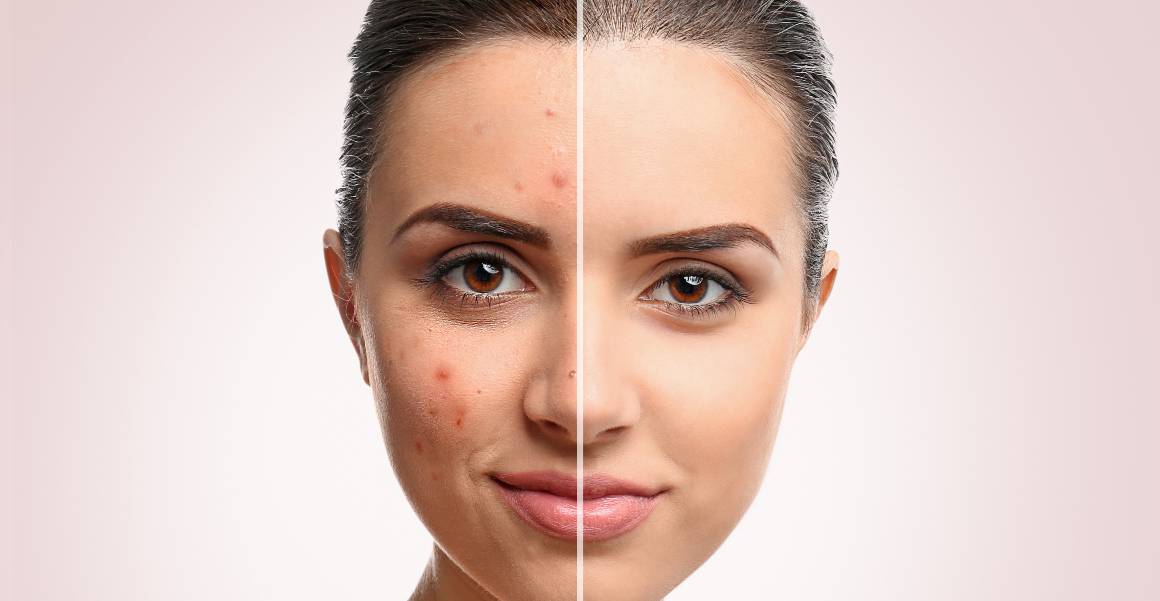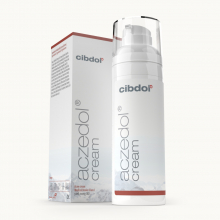What is the Main Cause of Acne?
Published:
Acne is one of the most common skin conditions, affecting around 85% of people at some point between the ages of 12 and 24. But what actually causes acne to develop in the first place?
Contents:
- How Does Acne Develop?
- Excess Sebum Is the Main Cause
- Why Does Excess Sebum Cause Acne?
- Other Contributing Factors
- Typical Causes By Age Group
- Common Acne Myths
- How Do You Treat Acne?
- Conclusion: Sebum Is the Primary Acne Culprit
- Frequently Asked Questions About The Main Cause of Acne
- What is the primary underlying cause of acne?
- How exactly does excess sebum cause acne?
- What role do hormones play?
- Can genetics influence acne?
- How do other factors like diet contribute?
- Does poor hygiene cause acne?
- Do greasy foods lead to breakouts?
- Should you avoid makeup to prevent acne?
- Does sunlight help to clear acne?
- Can you simply wash acne away?
- How do you treat acne effectively?
- Does acne go away on its own with age?
- What's the takeaway?
In this comprehensive guide, we'll explore the main factors that contribute to acne, discuss the primary underlying cause, and provide an overview of the conditions that can make acne worse.

How Does Acne Develop?
Before we dive into the root cause of acne, let's first look at how acne forms on the skin:
Acne starts when hair follicles (or pores) on the skin become clogged with excess oil and dead skin cells. This provides the ideal environment for the growth of a bacteria called Propionibacterium acnes, which naturally lives on the skin.
As P. acnes bacteria multiple rapidly inside the clogged follicle, inflammation sets in. This inflames the surrounding skin tissue and allows the area to become infected.
The result? Those unsightly red pimples, whiteheads and blackheads we know as acne.
So in summary, acne develops as a result of:
- Excess sebum (oil) production
- Build up of dead skin cells inside follicles
- Bacterial growth
- Inflammation
- Infection
But what is the primary factor that causes this sequence of events and allows acne to form?
Excess Sebum Is the Main Cause
The primary underlying cause of acne is overproduction of sebum (oil) in the skin.
Sebum is the oily, waxy substance that lubricates and protects our skin. It acts as a natural barrier against water loss and helps keep microbes and pathogens out.
Sebum is produced by sebaceous glands, which sit alongside hair follicles. These microscopic glands are found across our entire body, but are largest and most concentrated on the face, shoulders, upper chest and back - the areas where acne most commonly develops.
Why Does Excess Sebum Cause Acne?
There are two key reasons why excess sebum triggers the formation of acne:
1. It clogs up follicles
When sebaceous glands produce an excess of sebum, the oily substance can’t drain from the pores properly. Instead, it builds up inside hair follicles.
As sebum combines with dead skin cells that slough off within the follicle, it sticks together and forms a plug. This clogged environment is the perfect breeding ground for P. acnes bacteria.
2. It provides food for P. acnes
The oily, lipid-rich sebum provides the ideal food source for P. acnes bacteria. This allows P. acnes colonies to rapidly multiply and grow inside clogged follicles.
As bacterial levels rise, inflammation sets in - which leads to the formation of painful pimples and acne lesions.
So in summary:
- Excess sebum production increases oil levels on the skin
- This clogs up follicles and provides food for P. acnes bacteria
- Clogged follicles + P. acnes overgrowth = inflammation and acne
Other Contributing Factors
While excess sebum production is the primary cause, there are several other factors that can contribute to clogged pores and acne development:
Hormones
Hormonal changes during puberty, menstrual cycles and pregnancy can trigger increased sebum production and make acne worse.
Genetics
Some people inherit a genetic predisposition to produce more sebum. This makes them more prone to acne, especially during hormonal fluctuations.
Stress
Stress causes increased cortisol and inflammation in the body. This can worsen acne by triggering oil gland stimulation.
Medications
Certain medications like steroids, testosterone, lithium and hormones can boost sebum production and acne risk.
Diet
There is some evidence linking acne to high glycemic load diets and dairy consumption. These may influence hormonal factors.
Friction and pressure
Tight collars, headbands, helmets and backpacks can create friction that irritates follicles.
Skincare products
Greasy cosmetics, oils and thick creams can clog pores, as can harmful ingredients like isopropyl myristate.
So while these factors may worsen acne by increasing sebum production, the root cause remains overactive sebaceous glands producing too much oil in the first place.
Typical Causes By Age Group
Acne most often develops on the face, back, chest and shoulders. However, the underlying causes often differ between age groups:
Acne in teenagers:
Hormonal changes during puberty drive increased sebum production, causing breakouts.
Acne in adults:
Factors like stress, medications, diet, cosmetics and hormonal changes related to menstrual cycles or pregnancy can contribute to adult acne.
Acne in babies and infants:
Maternal hormones still circulating after birth may stimulate oil glands. This causes newborn or baby acne on the cheeks and nose.
Common Acne Myths
There are also plenty of myths about what causes acne. Let's bust some common acne misconceptions:
Myth: Acne is caused by poor hygiene
Reality: Dirt does not cause acne, but gentle cleansing can help remove excess oil.
Myth: Greasy foods cause acne
Reality: Specific foods like chips and chocolate do not determine acne risk. But higher glycemic diets may be linked to acne.
Myth: Makeup and cosmetics cause breakouts
Reality: Oil-free, non-comedogenic makeup will not clog pores. But heavy products like balms and thick creams might.
Myth: Sun exposure clears acne
Reality: Some sunlight exposure can temporarily improve pimples, but too much sun causes damage and pigmentation.
Myth: You'll grow out of acne
Reality: Acne often continues well into the 20s and 30s. About 5% of adults over 25 still struggle with acne.
Myth: Face washing prevents acne
Reality: Over-washing irritates skin. Gentle cleansing helps remove excess oil but does not treat the underlying cause.
Myth: Stress is a major acne trigger
Reality: Stress does not cause acne directly but can worsen it. The main cause still remains excess sebum production.
Myth: Working out causes acne
Reality: Exercise does not cause acne breakouts. But friction, sweat and gym products may clog pores and worsen acne.
How Do You Treat Acne?
Now that we've explored the primary cause of acne, let's briefly touch on treatment approaches that target overactive sebaceous glands:
- Topical retinoids like tretinoin help normalize oil production and are often prescribed first.
- Antibiotics like clindamycin and erythromycin fight P. acnes bacteria inside clogged follicles.
- Benzoyl peroxide kills acne bacteria and reduces oil gland activity.
- Oral contraceptives containing estrogen can help regulate hormonal fluctuations in women.
- Isotretinoin capsules dramatically reduce oil gland size and secretion to clear severe acne.
- Spironolactone tablets block androgens and reduce sebum production in adult women.
- Laser and light therapies using blue light or IPL target P. acnes bacteria while reducing sebum production.
Properly treating acne requires addressing the root cause - excess sebum secretion by overactive oil glands. Keep this front of mind when evaluating acne treatment options.
Conclusion: Sebum Is the Primary Acne Culprit
In summary, the main underlying cause of acne is overproduction of sebum by enlarged sebaceous glands in the skin. This key point underpins almost all acne development.
While other factors like hormones, genetics, diet and medication can drive increased sebum production and worsen acne, they are secondary to the primary impact of heightened oil secretion.
Understanding the pivotal role sebum plays in acne genesis helps inform treatment decisions and identify approaches that directly target the root cause.
Focusing on normalizing sebaceous gland function and minimizing excess sebum provides the best chance of clearing up frustrating breakouts for good.
Frequently Asked Questions About The Main Cause of Acne
Acne is an extremely common skin condition that affects up to 85% of people at some point. But what actually triggers acne to develop in the first place? Below we've compiled a list of frequently asked questions to shed light on the root cause of acne formation.
What is the primary underlying cause of acne?
The main factor that leads to acne development is overproduction of sebum (oil) by enlarged sebaceous glands in the skin. This excess oil provides the perfect environment for acne-causing bacteria to thrive.
How exactly does excess sebum cause acne?
There are two key ways overproduction of sebum leads to acne:
- It clogs up hair follicles as it combines with dead skin cells, allowing a plug to form.
- It provides the ideal food source for P. acnes bacteria. This allows colonies to rapidly multiply and grow inside clogged follicles.
What role do hormones play?
Hormonal changes during puberty, menstruation and pregnancy can drive increased sebum production. This makes acne worse, but hormones themselves are not the root cause.
Can genetics influence acne?
Yes. Certain individuals inherit a genetic predisposition to produce more sebum. This makes them more prone to acne breakouts.
How do other factors like diet contribute?
Diet, stress and other factors may worsen acne by increasing sebum production. But they are secondary to the main impact of overactive oil glands.
Does poor hygiene cause acne?
No. Dirt and lack of washing do not cause acne. But gentle cleansing helps remove excess oil from the skin.
Do greasy foods lead to breakouts?
Specific foods like chocolate do not determine acne risk directly. However, high glycemic load diets may be linked to acne due to hormone and oil gland factors.
Should you avoid makeup to prevent acne?
Makeup itself does not cause acne if it is oil-free and non-comedogenic. However, thick, heavy products can clog pores and worsen breakouts.
Does sunlight help to clear acne?
Some sunlight exposure may temporarily improve pimples. But too much sun causes damage. It does not treat the sebum issue at the root of acne.
Can you simply wash acne away?
Excessive washing irritates skin. While it removes surface oil, it does not address the underlying oil gland problem.
How do you treat acne effectively?
Topical retinoids, antibiotics, benzoyl peroxide, and oral medications like accutane inhibit oil gland activity and reduce sebum production. This treats the primary acne cause.
Does acne go away on its own with age?
Acne often continues into the 20s and 30s. Around 5% of adults over 25 still have acne. For some it persists life long due to ongoing sebum production.
What's the takeaway?
The key point to remember is that excess sebum secretion is the main driver of acne formation. Treatments that address this root cause by normalizing oil gland function have the best chance of clearing acne.










